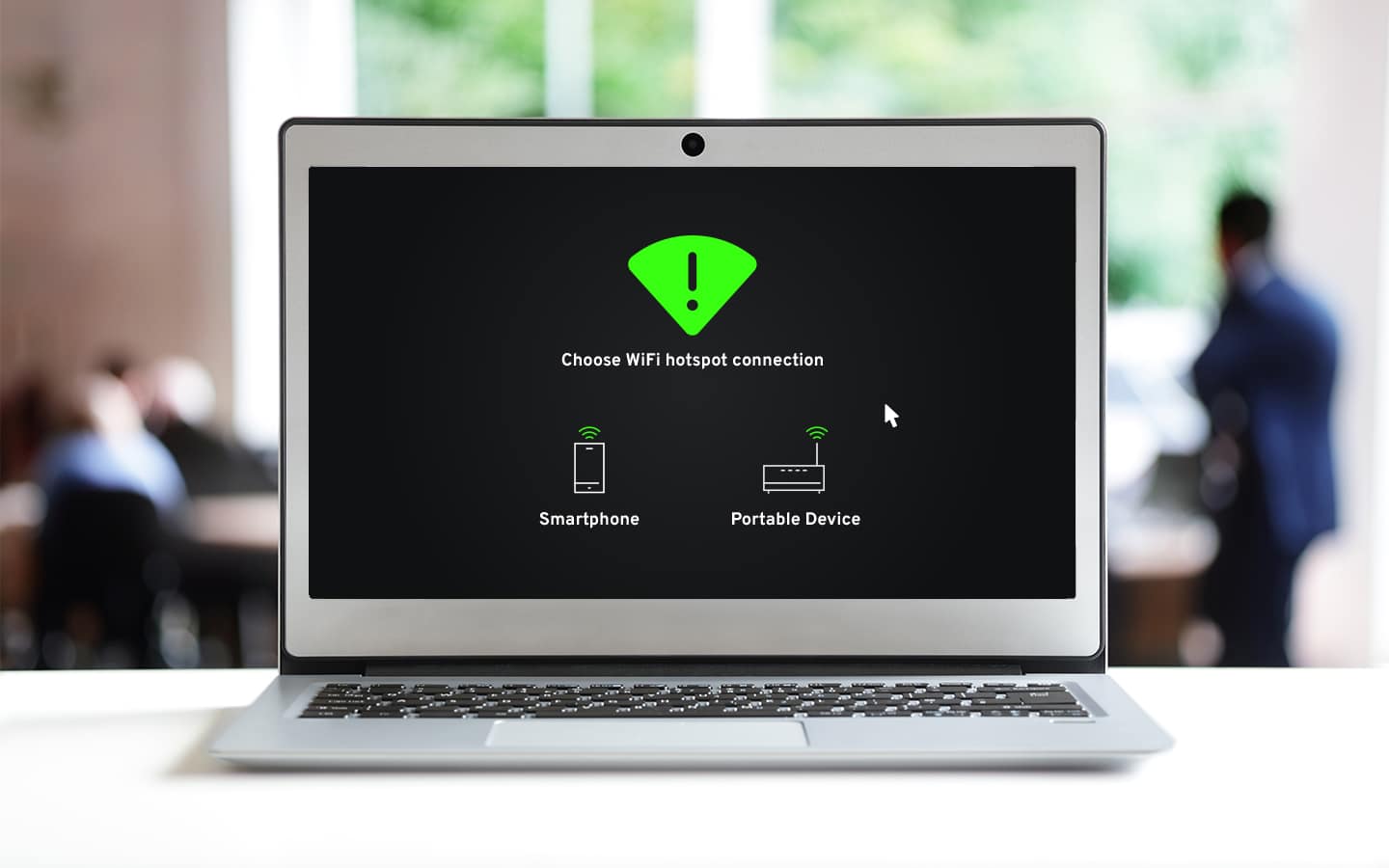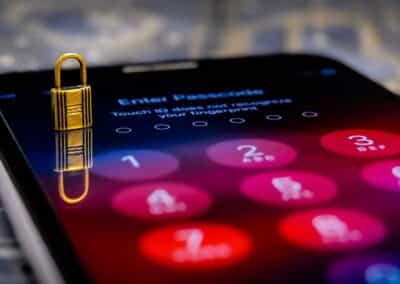
Whether you’re frequently on the go or you just want a steady internet connection to share with colleagues, mobile hotspots provide access to the internet from almost anywhere. Depending on your needs, you can set up a mobile hotspot using your smartphone’s internet connection, or through a dedicated portable mobile hotspot device. Regardless of which route you choose to go, it’s important to have an understanding of both options and the pros and cons of each. Let’s dive in.
What are mobile hotspots?
A mobile hotspot is created when a portable device uses cellular data to create a Wi-Fi signal that other devices can connect to in order to access the internet. There are two ways this can happen.
Smartphone mobile hotspot
A smartphone mobile hotspot is created by using a smartphone to convert a cellular data/LTE signal into a Wi-Fi network. It allows other devices to access the internet by using that smartphone as an access point.
Portable mobile hotspot
A portable mobile hotspot is essentially a pocket-sized mobile router. It’s a device that is specifically designed to share an internet connection with other devices that connect to it. These devices are set up with cellular data plans, allowing other devices to connect to the internet from almost anywhere.
How do mobile hotspots work?
Mobile hotspots make it easy to connect to the internet when you’re not at home or at an office, and the best part is that they’re easy to set up.
Smartphone mobile hotspots
Wondering how to set up a mobile hotspot on your smartphone? Here’s how to get started:
- Ensure that your carrier allows you to use mobile hotspots
- Go to the “settings” section on your phone, then navigate to “network”
- Turn on mobile hotspot
- Create your hotspot, then set up a name and password
- Connect your devices to the hotspot
- Congratulations, you now have internet access
Portable mobile hotspots
Creating a mobile hotspot on a dedicated device is easy, but the exact steps will vary depending on the model you buy. Here’s generally how it works:
- Purchase a hotspot device and activate a cellular data plan
- Navigate to the “settings” or “network screen”
- Create your mobile hotspot, then set up a name and password
- Connect your devices to the hotspot
- Monitor your data usage
Benefits of smartphone mobile hotspots:
Smartphone mobile hotspots are an affordable and simple way to access the internet on the go. There are a few key benefits to going this route:
- Affordability: By choosing to use your smartphone to create a mobile hotspot, your costs will be much cheaper up front, since you already own the device and have a service plan enabled.
- Convenience: A smartphone mobile hotspot can easily be turned on in settings and shared with others (usually up to ten connections).
- Portability: Your phone is always with you, making this option extremely portable, reliable, and user-friendly.
- Security: Your organization’sMobile Device Management (MDM) can easily be deployed to your phone for security purposes. Notably, MDMs cannot manage dedicated mobile hotspots on their own — additional software such as ,Asavie, is required. With the right apps on the host and tethered devices, you can also share a VPN connection through a mobile hotspot.
Drawbacks of smartphone mobile hotspots:
Despite being a viable option for many people, there are still a few drawbacks of smartphone mobile hotspots to watch out for:
- Access: Some carriers/phone plans may not include the hotspot feature, making it necessary for you to buy a separate mobile Wi-Fi device.
- Battery life: If you plan to frequently use your smartphone mobile hotspot for long periods of time, battery life may become a problem; this option can fully drain your battery in 1-2 hours if not connected to a power source. If you do choose to go this route, make sure to turn hotspot off when it’s no longer in use.
- Sharing: If your smartphone mobile hotspot is often used at home or on a job site as a main source of Wi-Fi for family, friends, or coworkers, it can lose many of its phone capabilities; you can’t walk away with it, leave the building, or turn it off without interrupting the internet connection.
- Users: Smartphone mobile hotspots usually only support 10 or fewer devices, so if you plan to use it as a hub for a larger number of people, you might want to opt for a dedicated hotspot device.
- Overages: If you’re using your smartphone as a mobile hotspot, you’ll be using your monthly cellular data to do so. It’s important to note that 1GB of data will allow you to browse the internet for about 12 hours, stream 200 songs or watch 2 hours of standard-definition video. But if you’re loading lots of pictures or videos, or sharing that data with multiple users, you’ll use it up even faster. If you don’t have a high data limit, you can easily run out of data or rack up expensive overage fees. Even if you have “unlimited” data, these plans are not actually unlimited, and generally start to throttle after a certain point.
- Connection: Smartphones aren’t primarily designed to act as hotspots. You might find that your connection is worse than it would be when using a dedicated mobile hotspot. This is especially true if your phone doesn’t have a great signal; your mobile hotspot connection is only as good as both your phone and network in that location.
Why you may need to invest in a portable mobile hotspot device:
If you find that you require a mobile hotspot often, it might be time to invest in a dedicated mobile hotspot device. Here’s why it might be a good choice:
- Convenience: With a separate device dedicated to creating an internet connection, you can continue to use your phone for what it was meant to do, or step away for a while without worrying about interrupting the connection for your group.
- Portability: Dedicated mobile hotspot devices are great for temporary job locations such as construction sites or mobile COVID testing sites. They can provide a strong, reliable network to be used when there isn’t access to Wi-Fi or wired internet.
- Purpose-built: Mobile hotspot devices sport an average of 6-10 hours of battery life and some may also have a built in power bank to charge your other devices with; this is perfect for those who need to use a hotspot extensively on a daily or weekly basis.
- More data: When you purchase a portable mobile hotspot device, you’ll also need to purchase a service plan with it. Considering that you’ll be purchasing a dedicated plan, rather than using your smartphone’s plan, you’ll likely have a higher data allowance.
- More users: If you find that you need to connect more than 10 devices to your mobile hotspot, a dedicated device may be the answer. Many dedicated portable mobile hotspots can support up to 15 or more devices.
Final thoughts
Smartphone mobile hotspots are a cost-effective and practical option for the average user. But based on your current lifestyle and mobile needs, purchasing a dedicated mobile hotspot device could be a smart investment. If you find that you often need to share your hotspot with others or that your hotspot usage is frequent enough to drain your phone battery, a portable mobile hotspot device is definitely worth considering.
Here at LINQ, we can help you decide which option is best for you and your company.
For more information, please contact [email protected]
LINQ Tech Team



